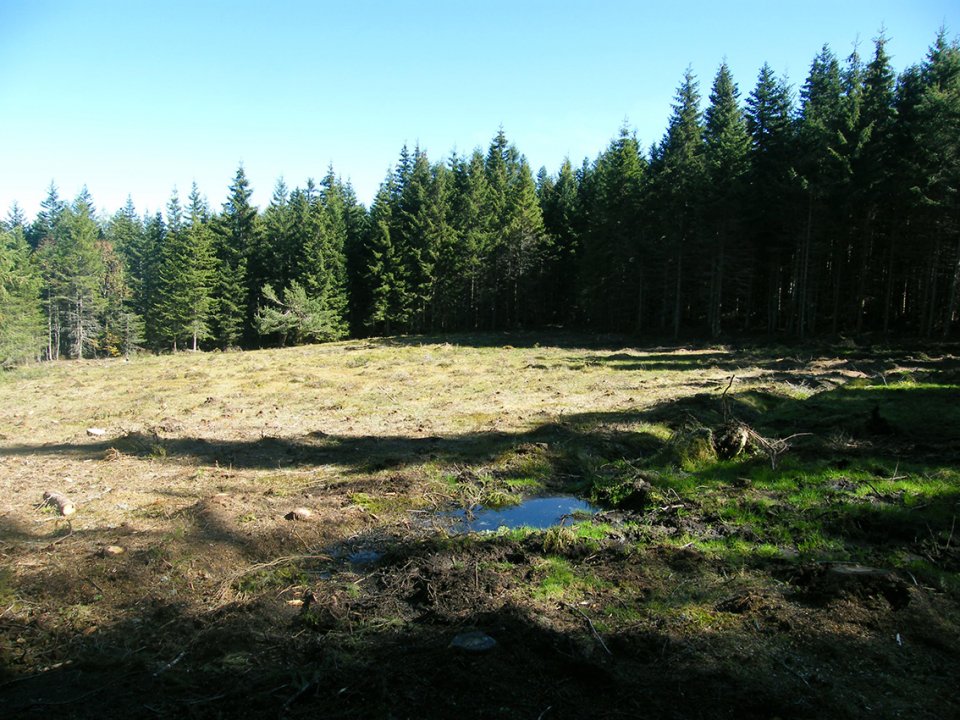
The Bac Pégullier site is situated on the northern slopes of the Madres range in the Pyrenees, in a typical mountain context made up of woodlands and pastures. The site is at an altitude between 1600 m and 1800 m and is therefore covered in snow for much of the year. The climatic conditions are therefore very harsh and
greatly influence the functioning of the site and natural habitats. The site consists of a mosaic of habitats divided into three sectors, with an upper zone covered by heathland, scarps, scree and Dwarf Mountain Pine, an intermediate zone covered by high forest of spruce and fir, and a lower zone covered by a mixture of spruce and fir and various types of broadleaf regrowth punctuated by numerous clearings or “sagnes”, the local name for fens. The specific feature of this site is the presence of about thirty spring fens of varying surfaces areas, totalling approximately 9 ha. Despite the very dense spruce plantations from the 1960s, the fens are still in a good functional and heritage condition; the actions of the management plan are aimed at improving the quality of this environment and therefore enhancing the functioning of the fens.
The area is subject to serious drought and flooding issues :
• In November 1999, flooding caused the deaths of 26 people in the Aude department.
• For many years, prefectorial decrees have drastically limited the use of water in the Aude.
• In October 2018, new floods killed 14 victims.
• For adaptation to climate changes : restore the hydraulic functioning of the fens to enhance flood retention and low water support.
• For biodiversity : restore the hydraulic functioning of the fens and conserve biodiversity.
In 2010, aware of the utility of these natural habitats positioned at the head of a catchment area, the Aude Departmental Council acquired these 63 hectares of forest in accordance with its jurisdiction concerning fragile natural areas. It then decided to carry out wetland restoration operations to attempt to recover better ecological and hydraulic functioning of these habitats and to conserve biodiversity. Indeed, the site harbours heritage animal species such as the Pyrenean Desman and Viviparous Lizard, and plant species characteristic of wetlands such as the Round-leaved Sundew, wich rely on the good quality of wetlands. The fens are connected together and flow into a stream that joins the River Aude several kilometres downstream. The Departmental Council commissioned an initial management plan in 2011-2012. In 2014 the works to restore the fens began by felling and removing the spruces growing in two of the most accessible fens (approximately 1.2 ha). The works were performed in such a way as to minimise the impacts on these fragile habitats (horse-drawn haulage). The works were carried out in September (at low water) and continued from 2015 to 2017.
BENEFITS REGARDING TARGETED ADAPTATION ISSUES
• Flooding and drought : the fens acquired better functionality for retaining the water at the head of the
catchment area and supporting the low water of the rivers downstream. An upcoming study of the department’s wetlands is set to confirm this.
BENEFITS FOR BIODIVERSITY
• 9 fens rehabilitated (4 hectares). The surveys revealed a rich flora with a typology characteristic of wet meadows and fens in terms of phytosociological analysis.
- Developing climate change adaptation; improving risk management and resilience
- Reduce drought risk
- Reduce flood risk
- Increase Biodiversity
Levers of success
• Technical skills : skilled service providers and project manager, a horse-drawn haulage company with experience of these habitats.
• Partnerships : good working relations between the horse-drawn haulage and wood removal companies and regular assessment meetings organised by the Department’s unit in charge of fragile natural areas (ENS).
• Rhône-Mediterranean-Corsica Water Agency (50 %)
• Aude Departmental Council (50 %)
Total budget: 224,150 € exc. VAT
Vincent Dumeunier, Environmental Unit
Aude Departmental Council

